Understanding Retrofit Windows: A Guide to Replacing Condominium Windows and HOA Responsibilities
Ready for spring showers? Make sure your windows are water-tight to protect your home from all sorts of damage.
Don't make these mistakes during your next window replacement! Windows are a critical piece of your building envelope that are responsible for maintaining its integrity, safety, and aesthetic appeal.
Are your condominium's windows due for a replacement? Proceed with caution—we see a failure rate of anywhere from 50-95% when condominiums replace their windows without the oversight of a building envelope expert.
Don't make these mistakes during your next window replacement:
Most of J2's building remediation projects involve a full evaluation of the existing windows. A condominium complex might have anywhere from 20 to several hundred windows and sliding glass doors, with varying levels of consistency based on past replacement directives from the HOA—this makes for a huge margin for defect when it comes to a highly technical part of building envelope design. (If you’re suspicious of windows being classified as “highly technical,” keep reading…)
We often encounter communities where individual unit owners have undertaken (or been directed) to do DIY window replacements, leading to a hodge-podge of colors, materials, and installation methods. This not only poses problems for the owners with subpar installations in their own unit, but we often find the units below the replaced windows begin to experience leaks originating from above.
(The photos below show different window types, frames, and obvious incorrect installation issues.)
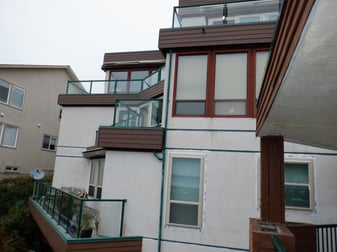
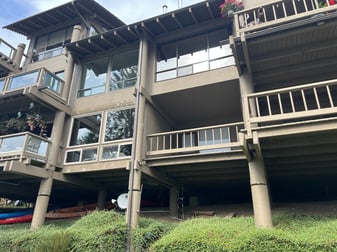
Since windows are so integral for weatherproofing, insulation, and ventilation—and since it’s so easy to get these things wrong if you don’t have the right team—we’re sharing our top tips for installation, codes, replacements, and frequently asked questions. Keep reading for more, or sign up for access to the Building Doctor Show if you want our free tips in webinar format.
Fin and Frame Integration with the WRB
We’re talking about nail fins first because this is the area where we see the biggest damage from water intrusion. Window fins, or flanges, are extensions of the window frame that help secure the window in the opening and integrate it with the weather-resistive barrier (WRB – think Tyvek or building paper) of the building.
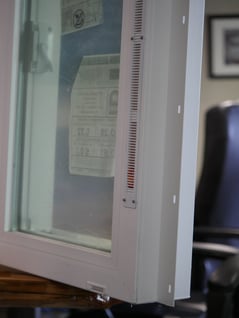

(The photo on the left shows a nail fin, the photo on the right shows the fin cut off, which is standard practice for replacement windows, or block frame windows that are used in masonry that require additional waterproofing.)
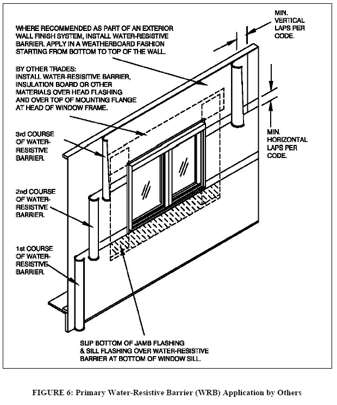
Source: AAMA 2400
Proper integration of window fins with the WRB is crucial to prevent water infiltration. The detail above is from the AAMA 2400 window installation Standard that shows how the WRB is integrated to the windows. Incorrect installation can lead to water bypassing the window and causing damage to the building envelope. Ensuring that the fins are sealed and integrated correctly with the WRB is essential for effective moisture management. More on that later.
Window Weatherstripping – Prevents Water From Coming Through the Window
Weatherstripping plays a key role in sealing the window against air and water infiltration. This is a combination of rubber gaskets, felt strips, sealant, and sealant tape. Despite this, water can still find its way through the window, so the weeps help that water evacuate the window frame. Your weeps will need regular maintenance to stay clean and functioning.
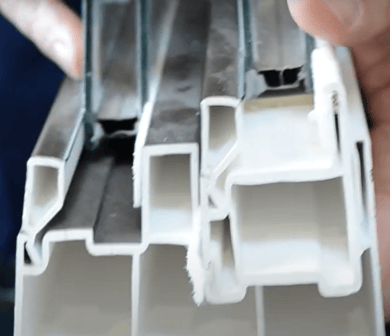
Sill Track and Weep Holes
The sill track at the bottom of the window collects water that may infiltrate the system and directs it out through weep holes. These holes allow water to escape rather than accumulate, which could otherwise cause damage or lead to leaks inside the building.
Pro tip: Don’t cover your weeps! We often see evidence of homeowners or sloppy installers filling weep holes with sealant, which prevents the proper flow of water and leads to an overflowing window, which causes damage to the sill trim and wall cavity.
Window Materials
Different materials offer various benefits. Vinyl windows are cost-effective and low-maintenance, fiberglass windows provide excellent thermal performance and are more durable than vinyl, and clad wood windows offer the beauty of wood with the durability of an exterior cladding such as metal or fiberglass. Aluminum is the most common material in homes and multifamily buildings constructed between the 1950’s and 1980’s. Despite the frame materials, given a window’s typical lifespan of about 20-30 years, there is a prevalent need for replacements in many of our older projects.
J2 stands by several standards and codes that govern the installation and performance of windows. We reference many manufacturer’s standards, American Architectural Manufacturers Association (AAMA), American Society for Testing and Materials (ASTM), as well as J2’s custom design professional standards based on our experience that exceed the minimum requirements of state and national codes. Compliance with these standards ensures windows meet rigorous performance criteria such as water resistance and structural integrity, exceed the expected useful life, and maintain value for years to come.
Other factors such as site conditions, building shape and height, and building exposure to wind-driven rain also play a role in determining the robustness of the design—which is why you should consult with a design professional to assist you. A building on the coast or the top of a hill obviously receives more wind load than a building protected by surrounding terrain, and a building in Seattle vs Phoenix experience different levels of rainfall.
AAMA standards compared to J2’s details:



Source: AAMA 2400

This is the world in which J2 operates. We step into occupied buildings that have seen a variety of installation techniques over the years, resulting in damage and even life-safety concerns. We often see replacement windows with the nail fins cut off, popped into the existing window cavity, and intermittently caulked around the edges. Weep holes get covered, weather-resistive barriers are cut off and mislapped, and leaks abound, damaging the structural and fire-resistive components of your building.

.jpg?width=391&height=293&name=3.3%20(1).jpg)
A visual inspection by a trained professional is a great way to identify windows that have been improperly installed. Leaks often show up inside the unit or at the bottom corners of the window on the exterior. At first glance, we look for bubbling or peeling paint, soft or swelling wood, staining, and discoloration. You might see your window tracks filling up with water and overflowing rather than draining out, and your window sill might show signs of increased moisture.
Window Testing
J2 has window testing spray racks that allow us to set up a simulation “rainstorm” to test the performance of new and existing windows. (This testing method is defined in the standards mentioned previously.) Even when your windows are brand new, things can happen in the manufacturing process or during installation that can cause them to fail the performance test—we see roughly 20% of brand-new windows fail!
The goal of testing new windows is to catch these things before they are installed. If a window fails a test, repairs or replacements may be necessary. The manufacturer may make repairs on-site, or the contractor might replace the faulty window unit, at which point J2 may test once more for quality assurance. We recommend the brands that routinely pass testing well because they have a high-quality production process. Unfortunately, this changes over time as well, as the manufacturers get bought up by the next larger firm which then wants to cut costs and make it more profitable in the ever-evolving brand acquisitions that are a part of our economy.
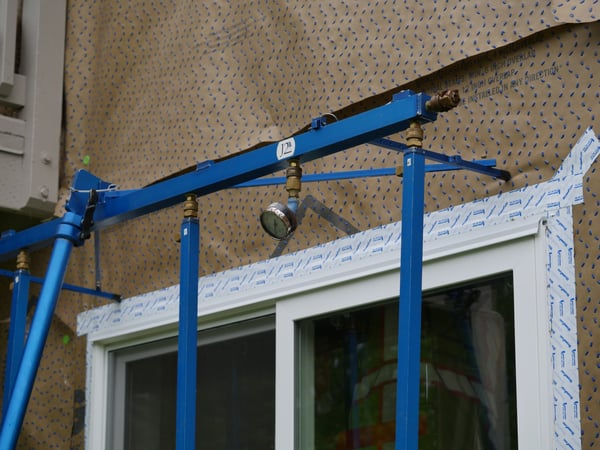
Definitions and Coverage
Understanding the difference between guarantees and warranties is important. Black’s Law Dictionary defines them this way:
The legal definition of warranty is “an assurance, promise, or guaranty by one party that a particular statement of fact is true and may be relied upon by the other party.” The legal definition of guarantee in noun form is “an undertaking or promise that is collateral to the primary or principal obligation and that binds the guarantor to performance in the event of nonperformance by the principal obligator.”
In plain language, this means that if your building envelope system does not work as promised, liability for the warranty transfers to the guarantor who, in our case, is the contractor or installer. A warranty typically covers defects in materials and workmanship, while a guarantee may cover broader issues such as installation and subsequent damage caused by product failure or installation problems.
Aside from the legal definitions, we often see fine print in warranties or guarantee language that exclude multifamily and condominium use altogether, or only provide this coverage to the original purchaser of the window, such as the developer, flipper, or the unit owner who replaced the windows prior to sale. This is especially common in the “lifetime guarantee” promise by the replacement installer or manufacturer, meaning the lifetime of the original purchaser, and their “lifetime” is measured in how long they own the unit. When the resident moves out, or the flipper is done with their flip, these windows typically become the HOA's responsibility as a common element, and therefore everyone’s problem to deal with in the future. We therefore advise HOA’s to be involved in how the building’s windows get replaced, if they are potentially on the hook for future repairs.
Which brings us to…
Who owns your building’s windows? Who is responsible for maintaining, repairing, and replacing them? These questions have more varied answers than you might think.
Oftentimes, we see HOA governing documents that state the homeowner is responsible for replacing the glass—meaning a broken pane of glass from a stray baseball or rock kicked up by a lawnmower, or a fogged window pane where the insulation seal has failed should be replaced by the homeowner. These are scenarios where the glass can be easily replaced without removing the frame. Since the finned windows are nailed to the framing of the building and integrated into the building’s WRB system under the cladding, most managers and HOA attorneys will view these as common elements whereas a full window frame replacement should be covered by the association.
Unfortunately, there are lots of governing documents that don’t fully clarify this and will leave ambiguity for each individual board to interpret in their own way, which may change from board to board as you experience turnover, even if that interpretation was incorrect. Just because we have always done it this way, does not make it compliant with your rules. What do your documents say? (Read them looking for this definition, and if you can’t find it, ask your HOA attorney for an opinion letter.)
Based on the thousands of units we’ve helped through this conundrum, we would recommend having some sort of standardization over your full window replacements, such as a standard set of details to follow and maybe even a list of preferred installers. When homeowners can choose the material, color, installation technique, and contractor for their window replacement, you end up with potential leaks and a building that looks like a patchwork quilt. Let’s look at those photos one more time…
-1.png?width=337&height=449&name=Image%20(1)-1.png)
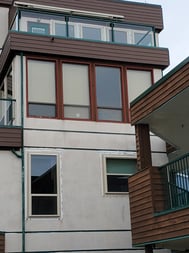
The photo on the left shows 3 different window types in one stack and the photo on the right shows 4 different window types (and colors!) and improper installation techniques that led to damage.
When homeowners and HOAs attempt to “DIY” their building maintenance and repair, the topic of window maintenance and replacement is often far more complex than they bargained for. Windows are a critical piece of your building envelope that are responsible for maintaining its integrity, safety, and aesthetic appeal.
While it may seem tempting to cut off the nail fins, pop the window into the wall, and caulk around the edges, we’ve seen these shortcuts result in damage, arguments, and extra costs (especially in the long term).
J2 always recommends a higher standard of excellence for building owners who want to see their building envelope withstand the wear of weather and time. We ensure proper integration with the weather-resistive barrier, adherence to code, and elevated design standards, and communicate the nuances of warranties and installation responsibilities to every client.
Have questions about your window situation? Give us a call.
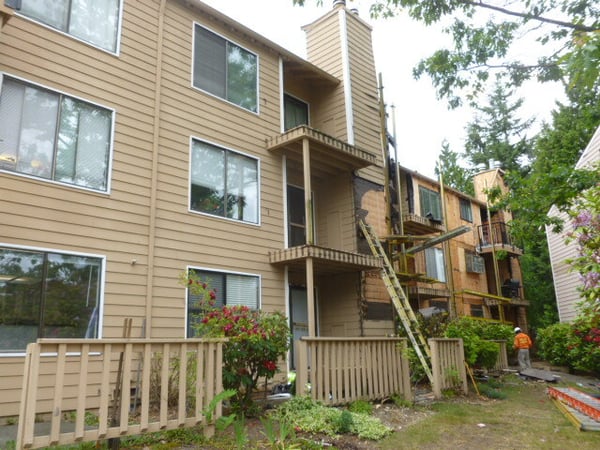

Ready for spring showers? Make sure your windows are water-tight to protect your home from all sorts of damage.
Condo window care made simple—cleaning, inspections, and maintenance tips to extend lifespan, boost comfort, and prevent costly repairs.
Living in a coastal area, do you have headaches whenever you see the rusted metal components in your building?
Be the first to know about new Building Doctor tips, lessons for condo Boards, and DIY building maintenance.